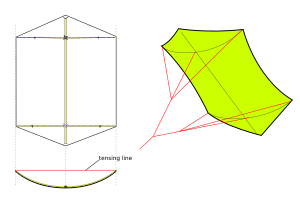Bowed kite facts for kids
Bowed kites are special types of kites that have a curved or "bowed" shape. This curve helps them fly much more steadily in the wind. Think of it like a boat with a curved hull that cuts through waves better. Famous examples include the Japanese Rokkaku kite and older versions of the common "diamond" shaped kites, like those from Malaysia or the Eddy kite. Because of their stable design, these kites often don't even need a tail to fly well!
The classic diamond kite, which usually has a simple two-point string system (called a bridle), can wobble or flutter a lot in the air. But if you add a bow to its horizontal stick (called a spar), this wobbling is greatly reduced or even stopped completely. Some newer kite designs use a fixed plastic piece that creates a dihedral shape, which is like a permanent V-shape, instead of a bendable bowed spar. This achieves the same great stability without needing to bend the stick.
Contents
What Makes a Kite Bowed?
A bowed kite gets its name from the way its main horizontal spar (the stick going across) is bent or curved. This bend is usually created by a string or line that pulls the ends of the spar towards the back of the kite. This tension creates the distinctive bow shape. This design is not just for looks; it's a clever way to make the kite fly better.
Why Bowing Helps Kites Fly Better
The curved shape of a bowed kite helps it in several ways:
- Increased Stability: When wind hits a flat kite, it can push it around unevenly, causing it to spin or dive. A bowed kite, however, acts like a wing. The curved surface helps the air flow smoothly over it, creating more stable lift. This means the kite is less likely to tumble or sway from side to side.
- Natural Balance: The bow helps the kite balance itself in the air. If one side of the kite gets more wind, the curved shape naturally adjusts, preventing it from flipping over. This is why many bowed kites don't need a long tail, which is often used on flat kites to add drag and stability.
- Better Wind Performance: Bowed kites can often handle a wider range of wind conditions. They can fly well in lighter winds because of their efficient shape, and they can also remain stable in stronger winds without getting out of control.
Famous Bowed Kites
Many traditional kites from around the world use a bowed design because of its effectiveness.
The Japanese Rokkaku Kite
The Rokkaku is one of the most famous bowed kites. It's a traditional Japanese fighting kite, meaning people fly them to try and cut down other kites!
- Shape: The Rokkaku is a six-sided kite, which is where its name comes from ("Rokkaku" means "six corners" in Japanese). It's usually taller than it is wide.
- Bowing: Its main horizontal spar is bowed, giving it excellent stability and control. This makes it very popular for kite fighting, as pilots need precise movements.
- Popularity: Rokkaku kites are not just for fighting; they are also flown for fun and in kite festivals around the world because of their beautiful flight characteristics.
Diamond Kites with a Bow
While many modern diamond kites are flat, the original designs, especially from places like Malaysia (often called Malay kites) or the Eddy kite, often featured a bowed horizontal spar. This simple addition transformed a potentially wobbly kite into a much more reliable flyer. The bow helps the kite "grip" the air better, making it less prone to spinning or diving unexpectedly.
Modern Alternatives to Bowing
Today, some kite designers use different methods to achieve the same stability that bowing provides.
- Dihedral Angle: Instead of a flexible spar that bends, some kites use a fixed "dihedral" shape. This means the kite is built with a permanent V-shape, like the wings of many airplanes. This V-shape helps the kite self-correct in the wind, much like a bowed spar does. It provides stability without needing to manually bend the kite.
- Stiff Materials: Modern materials and construction techniques allow for very stiff kite frames that can be designed with built-in stability, sometimes reducing the need for a pronounced bow.
Bowed kites are a great example of how simple design changes can make a big difference in how something performs. Their stable flight makes them a joy to watch and fly!
See also
 In Spanish: Cometa diédrica para niños
In Spanish: Cometa diédrica para niños


